Investigation the Effects of Different Earthquake Scaling Methods on Nonlinear Site-Amplification Analyzes
Abstract
1. Introduction
2. Study Area
2.1. Geology and Seismicity of the Area


2.2. Determination of the Site-Specific Dynamic Shear Modulus and Damping Ratio
3. Site-Specific Soil Behavior and TEC 2018
4. Site Response Analyses
5. Results
Ground Surface Acceleration Values and Soil Amplification
6. Conclusions
Author Contributions
Funding
Institutional Review Board Statement
Informed Consent Statement
Data Availability Statement
Conflicts of Interest
References
- Shah, S.H.; Lin, A.; Lin, S.; Patel, J.S.; Lam, M.; Zhu, K. Turkey’s Earthquakes: Damage Prediction and Feature Significance Using A Multivariate Analysis. arXiv 2024. [Google Scholar] [CrossRef]
- Dogan, K.; Yavuz, G.; Mehmet, K.; Kivanc, K. An overview of the current seismicity of the Sultandağı Fault Zone (Afyonkarahisar- Konya, Western Anatolia). Bull. Miner. Res. Explor. 2020, 163, 187–210. [Google Scholar] [CrossRef]
- Collins, O.; Molua, J.; Ataman, O. Dynamic Analysis of Soil-Structure Interaction in Earthquake-Prone Areas. Int. J. Appl. Struct. Mech. 2024, 1, 19–29. [Google Scholar] [CrossRef]
- Choi, Y.; Stewart, J.P. Nonlinear Site Amplification as Function of 30 m Shear Wave Velocity. Earthq. Spectra 2005, 21, 1–30. [Google Scholar] [CrossRef]
- Kempton, J.J.; Stewart, J.P. Prediction Equations for Significant Duration of Earthquake Ground Motions considering Site and Near-Source Effects. Earthq. Spectra 2006, 22, 985–1013. [Google Scholar] [CrossRef]
- Masi, A.; Santarsiero, G.; Chiauzzi, L.; Gallipoli, M.; Piscitelli, S.; Vignola, L.; Bellanova, J.; Calamita, G.; Perrone, A.; Lizza, C.; et al. Different damage observed in the villages of Pescara del Tronto and Vezzano after the M6.0 August 24, 2016 central Italy earthquake and site effects analysis. Ann. Geophys. 2017, 59, 1–12. [Google Scholar] [CrossRef]
- Buratti, N.; Stafford, P.J.; Bommer, J.J. Earthquake Accelerogram Selection and Scaling Procedures for Estimating the Distribution of Drift Response. J. Struct. Eng. 2010, 137, 345–357. [Google Scholar] [CrossRef]
- Bol, E. Adapazarı Zeminlerinin Dinamik Özellikleri. Ph.D. Thesis, Sakarya University, Serdivan, Türkiye, 2009. [Google Scholar]
- Sancio, R.B. Ground Failure and Building Performance in Adapazarı, Turkey. Ph.D. Thesis, University of California, Berkeley, CA, USA, 2003. [Google Scholar]
- Zhou, W.; Chen, Y.; Ma, G.; Yang, L.; Chang, X. A modified dynamic shear modulus model for rockfill materials under a wide range of shear strain amplitudes. Soil Dyn. Earthq. Eng. 2017, 92, 229–238. [Google Scholar] [CrossRef]
- Bayat, M.; Ghalandarzadeh, A. Stiffness degradation and damping ratio of sand-gravel mixtures under saturated state. Int. J. Civ. Eng. 2017, 16, 1261–1277. [Google Scholar] [CrossRef]
- ASTM. D4015-15; Standard Test Methods for Modulus and Damping of Soils by Resonant-Column Method. ASTM: West Conshohocken, PA, USA, 2021.
- ASTM D4767-11; Standard Test Method for Consolidated Undrained Triaxial Compression Test for Cohesive Soils. ASTM: West Conshohocken, PA, USA, 2020.
- Sexena, S.K.; Reddy, K.R. Dynamic moduli and damping ratios for monterey no.0 sand by resonant column tests. Soils Found. 1989, 29, 37–51. [Google Scholar] [CrossRef]
- Dutta, T.T.; Saride, S.; Jallu, M. Effect of saturation on dynamic properties of compacted clay in a resonant column test. Geomech. Geoengin. 2017, 12, 181–190. [Google Scholar]
- Li, H.; Senetakis, K. Effects of particle grading and stress state on strain-nonlinearity of shear modulus and damping ratio of sand evaluated by resonant-column testing. J. Earthq. Eng. 2020, 24, 1886–1912. [Google Scholar] [CrossRef]
- Morsy, A.M.; Salem, M.A.; Elmamlouk, H. Evaluation of dynamic properties of calcareous sands in Egypt at small and medium shear strain ranges. Soil Dyn. Earthq. Eng. 2019, 116, 692–708. [Google Scholar] [CrossRef]
- Güler, E.; Afacan, K.B. Düşük Deformasyon Seviyelerinde Kumların Dinamik Özelliklerinin Resonant Kolon Deneyi Yardımıyla Belirlenmesi. ECJSE 2020, 7, 572–580. [Google Scholar] [CrossRef]
- Kokusho, T. Cyclic triaxial test of dynamic soil properties for wide strain range. Soils Found. 1980, 20, 45–60. [Google Scholar]
- Kumar, S.; Krishna, A.M.; Dey, A. Evaluation of dynamic properties of sandy soil at high cyclic strains. Soil Dyn. Earthq. Eng. 2017, 99, 157–167. [Google Scholar] [CrossRef]
- Khan, Z.; El Naggar, M.H.; Cascante, G. Frequency dependent dynamic properties from resonant column and cyclic triaxial tests. J. Frankl. Inst. 2011, 348, 1363–1376. [Google Scholar] [CrossRef]
- El Mohtar, C.S.; Drnevich, V.P.; Santagata, M.; Bobet, A. Combined resonant column and cyclic triaxial tests for measuring undrained shear modulus reduction of sand with plastic fines. Geotech. Test. J. 2013, 36, 484–492. [Google Scholar] [CrossRef]
- Banerjee, S.; Balaji, P. Effect of anisotropy on cyclic properties of chennai marine clay. Int. J. Geosynth. Ground Eng. 2018, 4, 27. [Google Scholar] [CrossRef]
- Sobolev, E.; Ter-Martirosyan, A. Interaction of the base and construction under seismic action, with considering various characteristics of soil damping. MATEC Web Conf. 2018, 251, 04011. [Google Scholar] [CrossRef]
- Darendeli, M.B. Development of a New Family of Normalized Modulus Reduction and Material Damping Curves. Ph.D. Thesis, The University of Texas, Austin, TX, USA, 2001. [Google Scholar]
- Afacan, K.B. Evaluation of Nonlinear Site Response of Soft Clay Using Centrifuge Models. Ph.D Thesis, University of California, Los Angeles, CA, USA, 2014. [Google Scholar]
- Güler, E.; Afacan, K.B. Combined resonant column and cyclic triaxial tests to estimate the dynamic behavior of undisturbed saturated clayey soils of Adapazarı Turkey. Geomech. Eng. 2023, 33, 243–259. [Google Scholar] [CrossRef]
- Hashash, Y.M.A.; Musgrove, M.I.; Harmon, J.A.; Groholski, D.; Phillips, C.A.; Park, D. DEEPSOIL V6.1, User Manual; Board of Trustees of University of Illinois at Urbana-Champaign: Urbana, IL, USA, 2016. [Google Scholar]
- Silahtar, A. Evaluation of local soil conditions with 1D nonlinear site response analysis of Arifiye (Sakarya District), Turkey. Nat. Hazards 2023, 116, 727–751. [Google Scholar] [CrossRef]
- Ketin, İ. The North Anatolian Fault (Kuzey Anadolu Fayi Hakkinda). J. MTA. Bull. Miner. Res. Explor. 1969, 72, 1–27. [Google Scholar]
- Akat, U.; Akbaş, B.; Akdeniz, N.; Aksay, A.; Altun, İ.E.; Balcı, V.; Bilginer, E.; Bilgiç, T.; Duru, M.; Ercan, T.; et al. Prepared by the Geological Research Department of the General Directoate of Mineral Research and Exploration, Produced by ISLEM Geographic Information Systems Company in ARC/INFO 8.1 Environments, 2002 and Printed by General Command of Mapping. Topographic Information is Taken by Modifying from the 1:500.000 and 1:250.000 Scale Topographic Maps (Projection System is Lambert Conformal Conic) of General Command of Mapping (Ankara). 2002. Available online: https://www.mta.gov.tr/v3.0/hizmetler/jeoloji-haritalari (accessed on 4 January 2025).
- Emre, Ö.; Duman, T.Y.; Özalp, S.; Elmacı, H.; Olgun, Ş.; Şaroğlu, F. Açıklamalı Türkiye Diri Fay Haritası. Scale 1:1.250.000; Maden Tetkik ve Arama Genel Müdürlüğü: Ankara, Turkey, 2013; ISBN 978-605-5310-56-1. [Google Scholar]
- Afad, T.C. Ministry of Interior Disaster and Emergency Management Presidency. 2024. Available online: www.afad.gov.tr (accessed on 4 January 2025).
- Ansal, A.; Tönük, G.; Kurtuluş, A. Zemin büyütme analizleri ve sahaya özel tasarim depremi özelliklerinin belirlenmesi. In Proceedings of the 1. Türkiye Deprem Mühendisliği ve Sismoloji Konferansı, Ankara, Turkey, 11–14 October 2011; pp. 1–8. (In Turkish). [Google Scholar]
- Kalapodis, N.A.; Muho, E.V.; Beskos, D.E. Structure-specific, multi-modal and multi-level scalar intensity measures for steel plane frames. Soil Dyn. Earthq. Eng. 2025, 190, 109185. [Google Scholar]
- Muho, E.V.; Kalapodis, N.A.; Beskos, D.E. Multi-modal and multi-level structure-specific spectral intensity measures for seismic evaluation of reinforced concrete frames. Bull. Earthq. Eng. 2024, 22, 6955–6989. [Google Scholar]
- Liu, L.; Dobry, R. Seismic response of shallow foundation on liquefiable sand. J. Geotech. Eng. 2017, 123, 557–566. [Google Scholar] [CrossRef]
- Toksoz, M.N.; Reilinger, R.E.; Doll, G.; Barka, A.A. Izmit (Turkey) Earthquake of 17 August 1999: First Report. Seism. Res. Lett. 1999, 70, 669–679. [Google Scholar]
- PEER, Pacific Earthquake Engineering Research Center, Ground Motion Database. 2024. Available online: https://ngawest2.berkeley.edu/ (accessed on 4 January 2025).
- Özdemir, Z.; Fahjan, Y.M. Comparison of Time and Frequency Domain Scaling of Real Accelerograms to Match Earthquake Design Spectra. Sixth Natl. Conf. Earthq. Eng. 2007, 435, 446. [Google Scholar]
- Fahjan, Y.M. Selection and scaling of real earthquake accelerograms to fit the Turkish design spectra. Tek Dergi/Tech. J. Turk. Chamb. Civ. Eng. 2008, 19, 1231–1250. [Google Scholar]
- Alielahi, H.; Adampira, M. Seismic effects of two-dimensional subsurface cavity on the ground motion by BEM: Amplification patterns and engineering applications. Int. J. Civ. Eng. 2016, 14, 233–251. [Google Scholar] [CrossRef]
- Arslan, G.; Borekci, M.; Sahin, B.; Denizer, M.I.; Duman, K.S. Performance Evaluation of In-Plan Irregular RC Frame Buildings Based on Turkish Seismic Code. Int. J. Civ. Eng. 2018, 16, 323–333. [Google Scholar] [CrossRef]
- Ebrahimi Motlagh, H.R.; Rahai, A. Dynamic Response of a Continuous-Deck Bridge with Different Skew Degrees to Near-Field Ground Motions. Int. J. Civ. Eng. 2017, 15, 715–725. [Google Scholar] [CrossRef]
- Kramer, S.L. Geotechnical Earthquake Engineering; Prentice-Hall, Inc. Simon & Schuster/A Viacom Company: Upper Saddle River, NJ, USA, 1996. [Google Scholar]
- Güzel, Y.; Güzel, F. Investigation of local site efect considering the recordings of the 08.11.2021 earthquake event in Konya, Turkey. Nat. Hazards 2023, 116, 619–636. [Google Scholar]
- Makra, K.; Rovithis, E.; Riga, E.; Raptakis, D.; Pitilakis, K. Amplifcation features and observed damages in İzmir (Turkey) due to 2020 Samos (Aegean Sea) earthquake: Identifying basin efects and design requirements. Bull. Earthq. Eng. 2021, 19, 4773–4804. [Google Scholar]


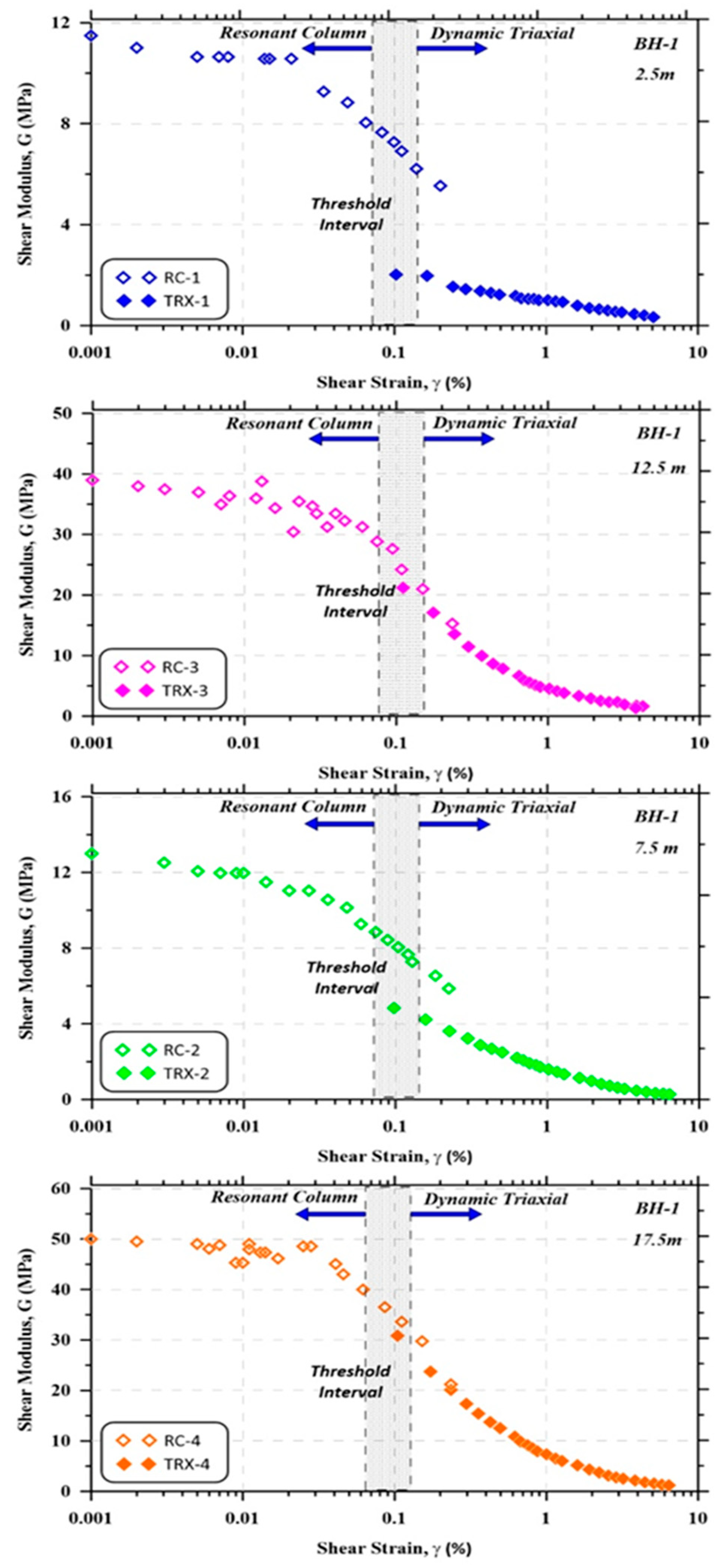
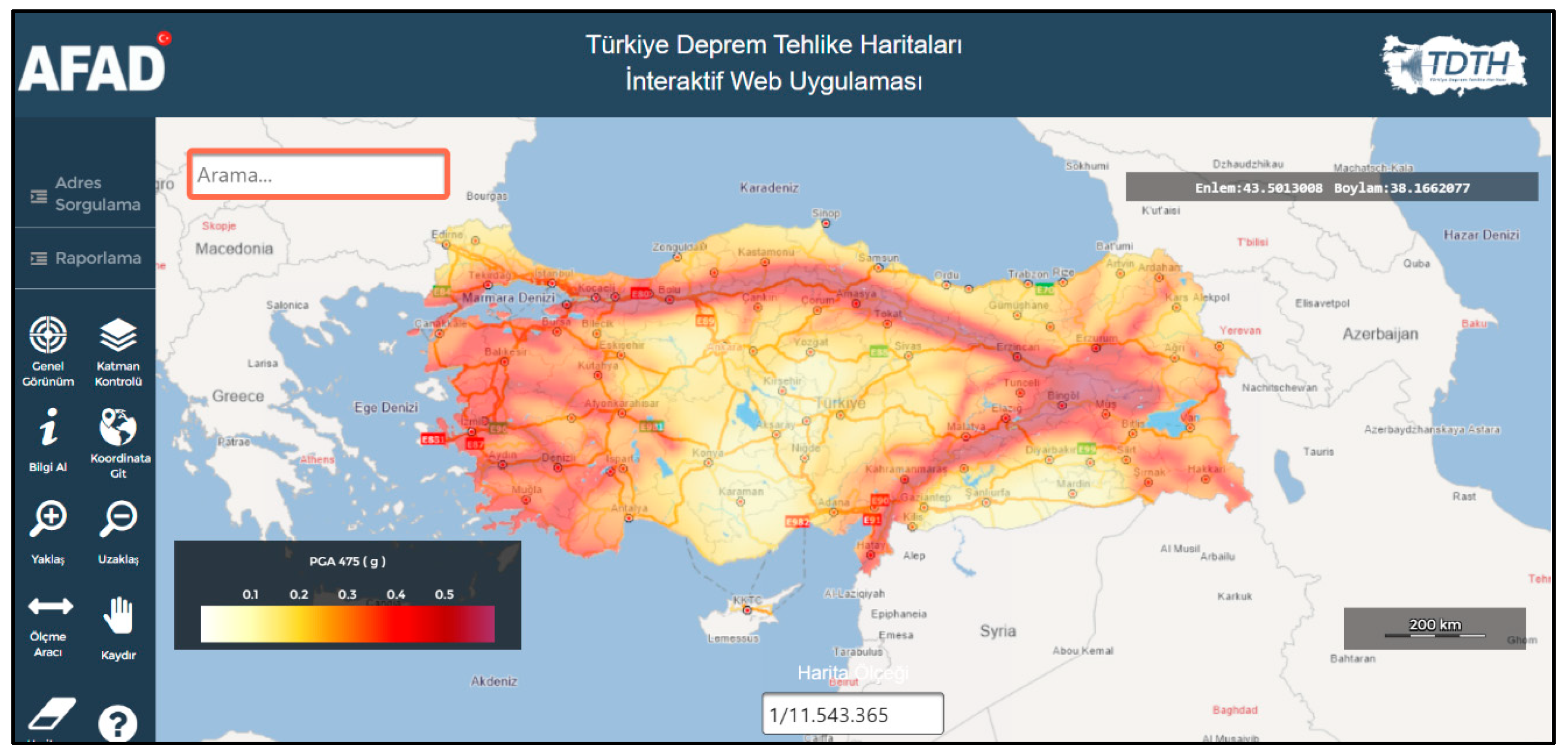

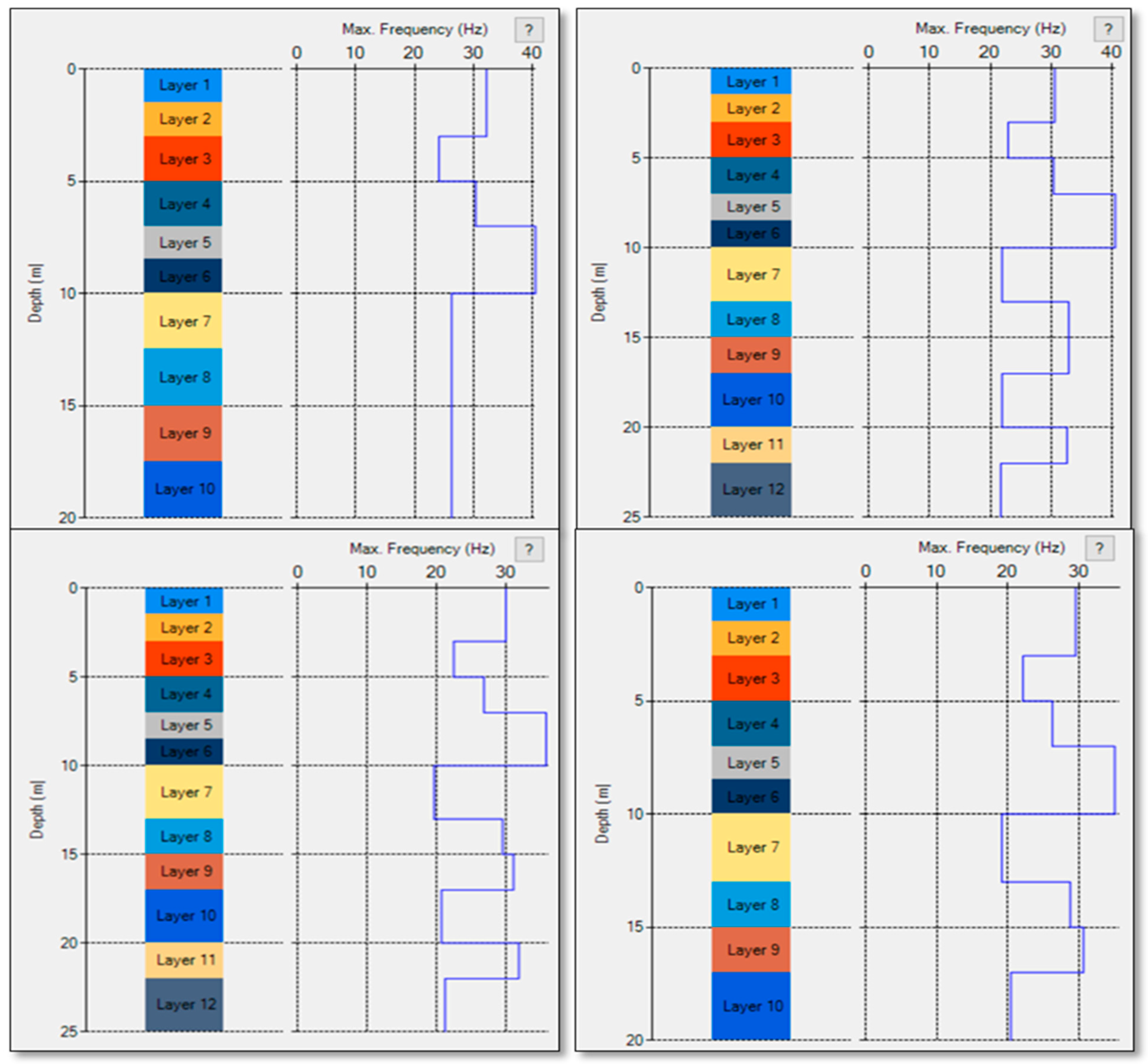

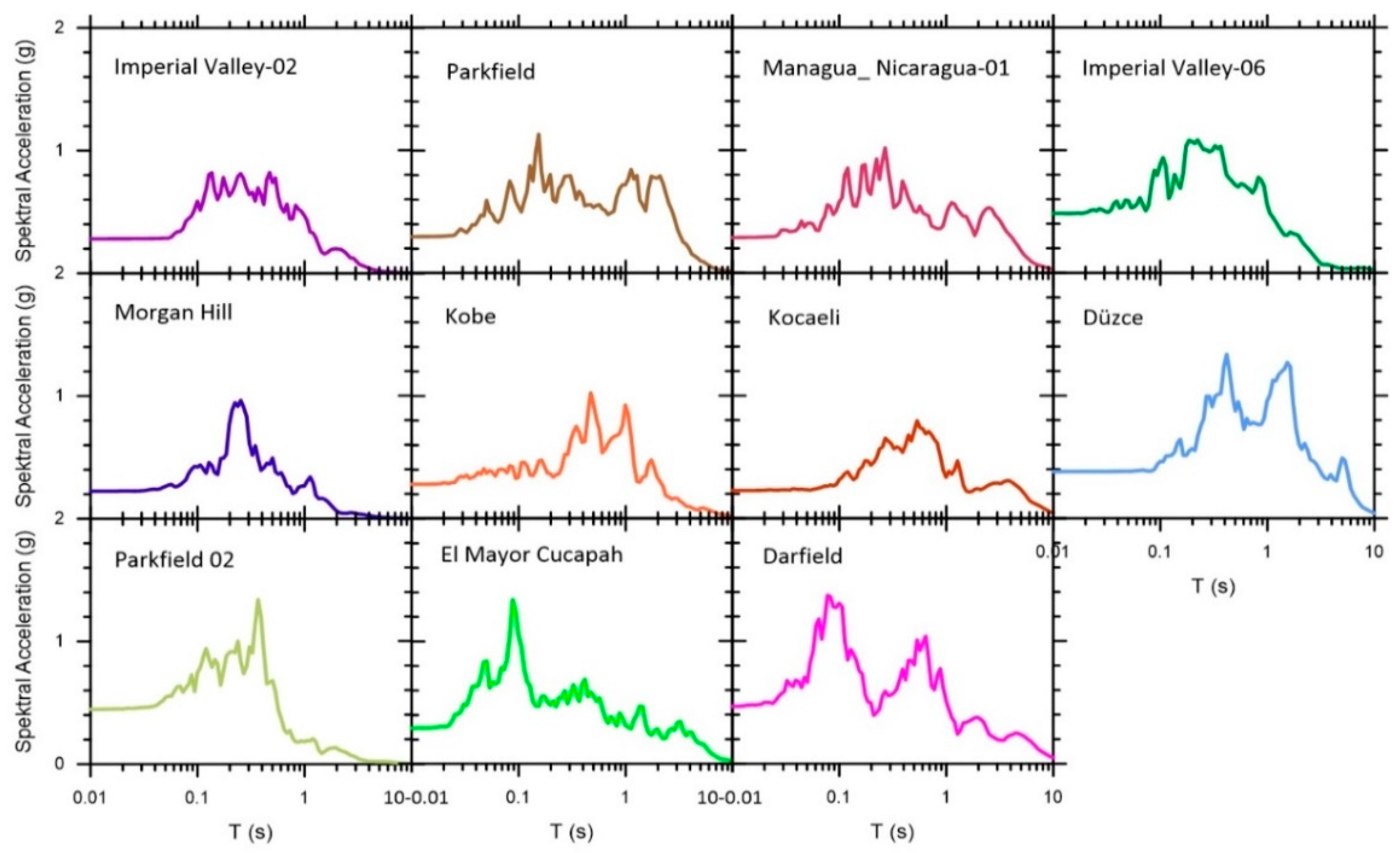

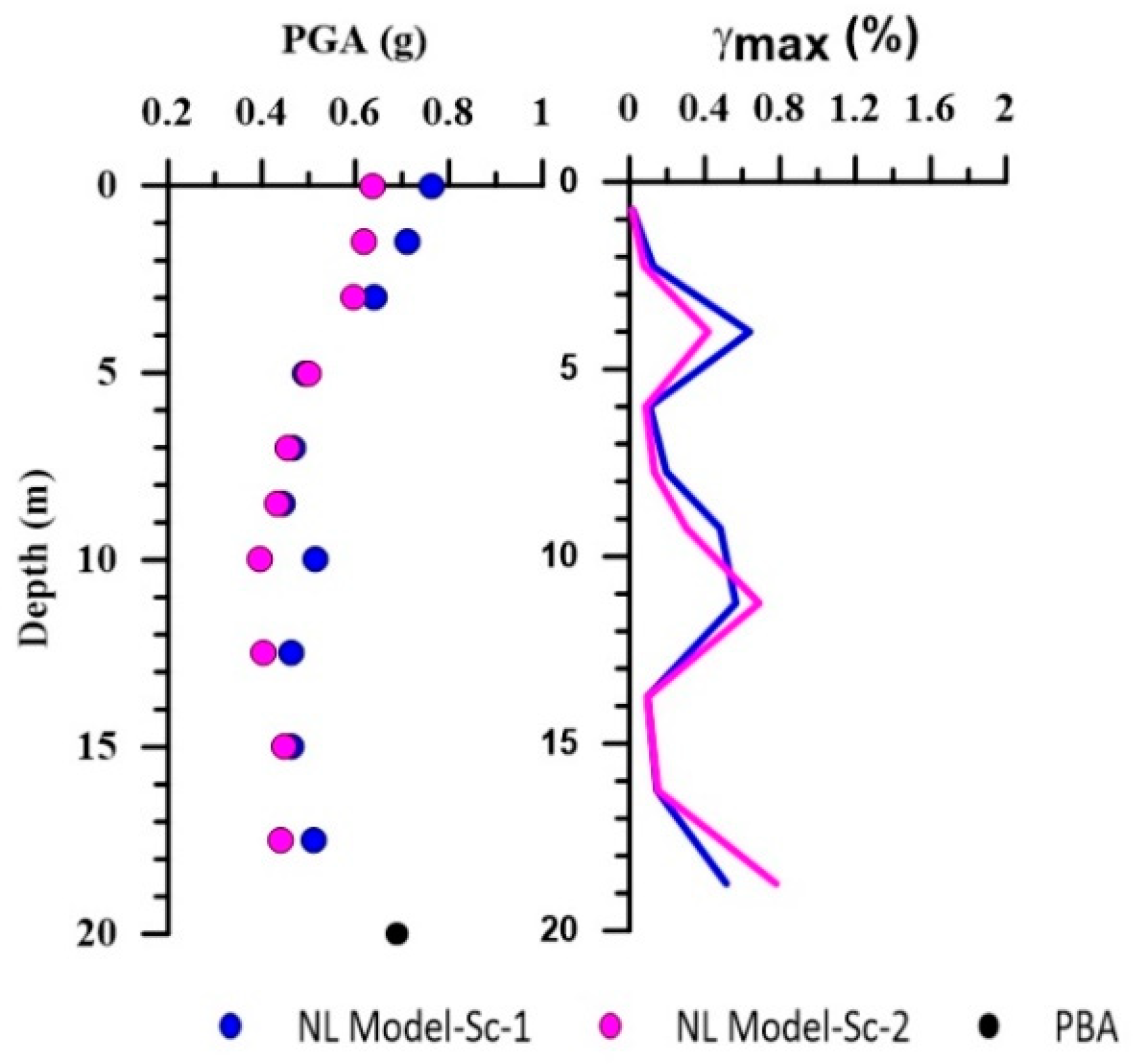
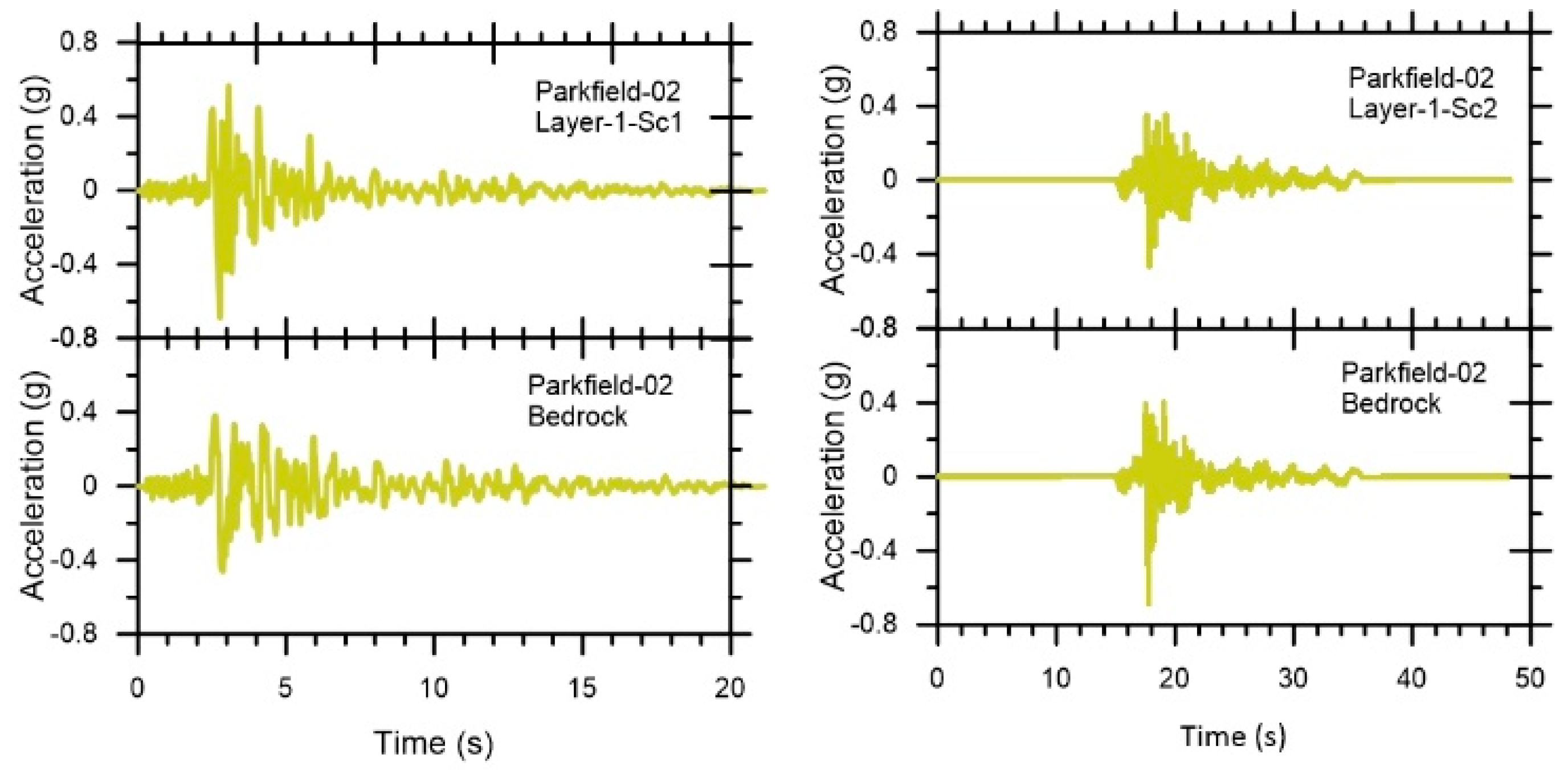

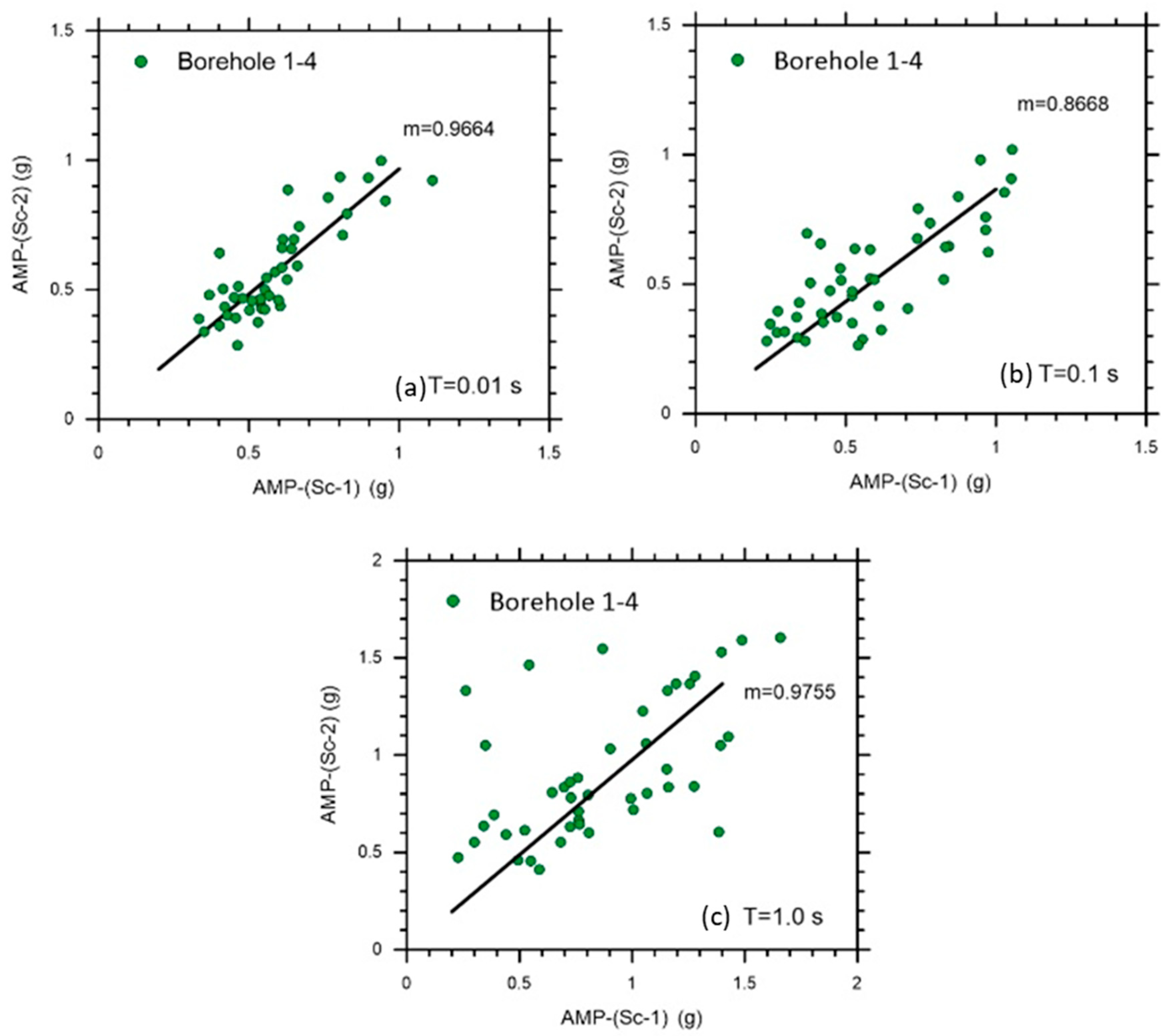

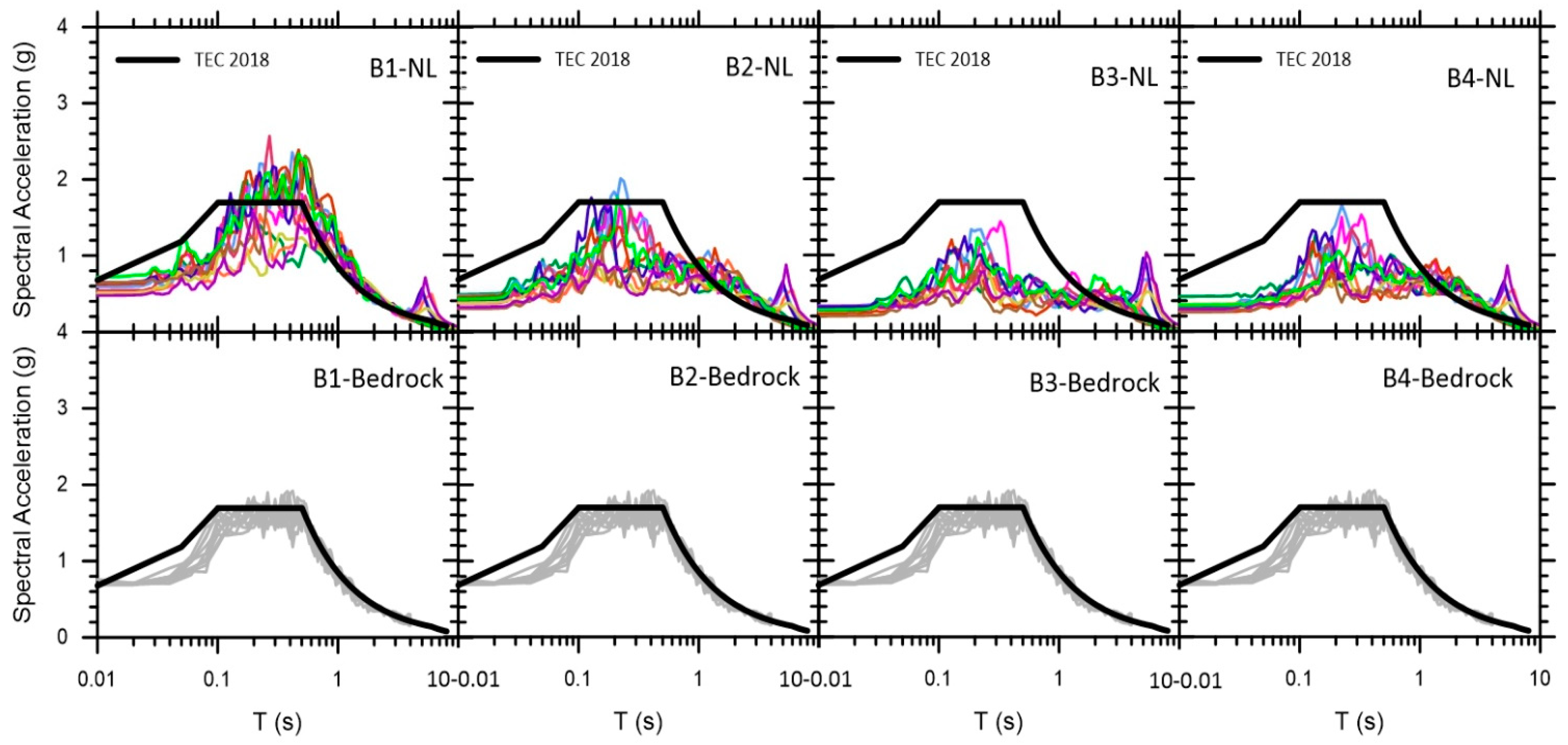
| BH No | Undisturbed Sample No | Layer No | Layer Thickness (m) | wn (%) | Cu (kPa) | PI (%) | Soil Type |
|---|---|---|---|---|---|---|---|
| BH-1 | UD-1 | Layer-1 | 1.50 | 41.48 | 50 | 17 | ML |
| Layer-2 | 1.50 | ||||||
| Layer-3 | 2.00 | ||||||
| UD-2 | Layer-4 | 2.00 | 43.56 | 60 | 19 | MH | |
| Layer-5 | 1.50 | ||||||
| Layer-6 | 1.50 | ||||||
| UD-3 | Layer-7 | 2.50 | 44.53 | 65 | 34 | CH | |
| Layer-8 | 2.50 | ||||||
| UD-4 | Layer-9 | 2.50 | 46.00 | 90 | 37 | CH | |
| Layer-10 | 2.50 | ||||||
| BH-2 | UD-1 | Layer-1 | 1.50 | 43.95 | 40 | 9 | CL |
| Layer-2 | 1.50 | ||||||
| Layer-3 | 2.00 | ||||||
| UD-2 | Layer-4 | 2.00 | 50.95 | 40 | 12 | CL | |
| Layer-5 | 1.50 | ||||||
| Layer-6 | 1.50 | ||||||
| UD-3 | Layer-7 | 3.00 | 50.35 | 45 | 16 | MH | |
| Layer-8 | 2.00 | ||||||
| UD-4 | Layer-9 | 2.00 | 53.46 | 70 | 24 | CH | |
| Layer-10 | 3.00 | ||||||
| UD-5 | Layer-11 | 2.00 | 58.13 | 70 | 27 | CH | |
| Layer-12 | 3.00 | ||||||
| BH-3 | UD-1 | Layer-1 | 1.50 | 48.40 | 40 | 10 | ML |
| Layer-2 | 1.50 | ||||||
| Layer-3 | 2.00 | ||||||
| UD-2 | Layer-4 | 2.00 | 45.92 | 40 | 16 | CL | |
| Layer-5 | 1.50 | ||||||
| Layer-6 | 1.50 | ||||||
| UD-3 | Layer-7 | 3.00 | 46.68 | 40 | 19 | MH | |
| Layer-8 | 2.00 | ||||||
| UD-4 | Layer-9 Layer-10 | 2.00 | 50.52 | 40 | 21 | MH | |
| 3.00 | |||||||
| UD-5 | Layer-11 | 2.00 | 49.89 | 60 | 28 | CH | |
| Layer-12 | 3.00 | ||||||
| BH-4 | UD-1 | Layer-1 | 1.50 | 42.24 | 30 | 7 | ML |
| Layer-2 | 1.50 | ||||||
| Layer-3 | 2.00 | ||||||
| UD-2 | Layer-4 | 2.00 | 45.88 | 40 | 10 | ML | |
| Layer-5 | 1.50 | ||||||
| Layer-6 | 1.50 | ||||||
| UD-3 | Layer-7 | 3.00 | 45.30 | 40 | 14 | CL | |
| Layer-8 | 2.00 | ||||||
| UD-4 | Layer-9 | 2.00 | 48.58 | 50 | 16 | ML | |
| Layer-10 | 3.00 |
| Soil Type | Definition |
|---|---|
| ZA | Sound, hard rocks Vs(30) > 1500 |
| ZB | Slightly weathered, medium sound rocks 760< Vs(30) < 1500 |
| ZC | Very dense sand, gravel, and hard clay layers or dissociated, very cracked weak rocks 360 < Vs(30) < 760 |
| ZD | Medium dense—dense sand, gravel, or very solid clay layers 180 < Vs(30) < 360 |
| ZE | Loose sand, gravel, or soft—solid clay layers or profles with a soft clay layer (cu < 25 kPa) thicker than 3 m, providing PI > 20 and w > 40% conditions Vs(30) < 180 |
| ZF | Soils that require site-specific research and evaluation. |
| No | Earthquake | Year | Station | Magnitud (M) | Fault Type | PGA | Rjb (km) | Rrup (km) | Vs30 (m/sec) |
|---|---|---|---|---|---|---|---|---|---|
| 1 | “Imperial Valley-02” | 1940 | “El Centro Array #9” | 6.95 | Strike Slip | 0.280 | 6.09 | 6.09 | 213.44 |
| 2 | “Parkfield” | 1966 | “Cholame—Shandon Array #5” | 6.19 | Strike Slip | 0.443 | 9.58 | 9.58 | 289.56 |
| 3 | “Managua_ Nicaragua-01” | 1972 | “Managua_ Esso” | 6.24 | Strike Slip | 0.371 | 3.51 | 4.06 | 288.77 |
| 4 | “Imperial Valley-06” | 1979 | “El Centro Array #4” | 6.53 | Strike Slip | 0.484 | 4.9 | 7.05 | 208.91 |
| 5 | “Morgan Hill” | 1984 | “Gilroy Array #4” | 6.19 | Strike Slip | 0.224 | 11.53 | 11.54 | 221.78 |
| 6 | “Kobe_ Japan” | 1995 | “Amagasaki” | 6.9 | Strike Slip | 0.275 | 11.34 | 11.34 | 256.00 |
| 7 | “Kocaeli_ Turkey” | 1999 | “Yarimca” | 7.51 | Strike Slip | 0.226 | 1.38 | 4.83 | 297.00 |
| 8 | “Duzce_ Turkey” | 1999 | “Duzce” | 7.14 | Strike Slip | 0.404 | 0 | 6.58 | 281.86 |
| 9 | “Parkfield-02_ CA” | 2004 | “Parkfield—Cholame 4aw” | 6.0 | Strike Slip | 0.302 | 4.81 | 5.53 | 283.38 |
| 10 | “El Mayor-Cucapah_ Mexico” | 2010 | “Cerro Prieto Geothermal” | 7.2 | Strike Slip | 0.286 | 8.88 | 10.92 | 242.05 |
| 11 | “Darfield_ New Zealand” | 2010 | “Linc” | 7.0 | Strike Slip | 0.461 | 5.07 | 7.11 | 263.2 |
Disclaimer/Publisher’s Note: The statements, opinions and data contained in all publications are solely those of the individual author(s) and contributor(s) and not of MDPI and/or the editor(s). MDPI and/or the editor(s) disclaim responsibility for any injury to people or property resulting from any ideas, methods, instructions or products referred to in the content. |
© 2025 by the authors. Licensee MDPI, Basel, Switzerland. This article is an open access article distributed under the terms and conditions of the Creative Commons Attribution (CC BY) license (https://creativecommons.org/licenses/by/4.0/).
Share and Cite
Güler, E.; Afacan, K.B. Investigation the Effects of Different Earthquake Scaling Methods on Nonlinear Site-Amplification Analyzes. Appl. Sci. 2025, 15, 3566. https://doi.org/10.3390/app15073566
Güler E, Afacan KB. Investigation the Effects of Different Earthquake Scaling Methods on Nonlinear Site-Amplification Analyzes. Applied Sciences. 2025; 15(7):3566. https://doi.org/10.3390/app15073566
Chicago/Turabian StyleGüler, Ersin, and Kamil Bekir Afacan. 2025. "Investigation the Effects of Different Earthquake Scaling Methods on Nonlinear Site-Amplification Analyzes" Applied Sciences 15, no. 7: 3566. https://doi.org/10.3390/app15073566
APA StyleGüler, E., & Afacan, K. B. (2025). Investigation the Effects of Different Earthquake Scaling Methods on Nonlinear Site-Amplification Analyzes. Applied Sciences, 15(7), 3566. https://doi.org/10.3390/app15073566






